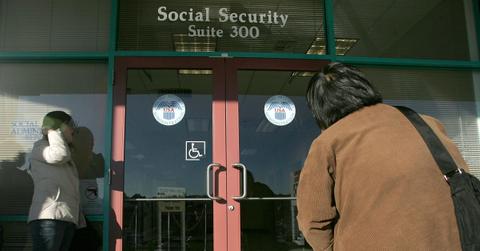Social Security Mail Delays Tracked to “Critical Issues” at SSA Facilities
Social Security mail delays are the result of “critical issues” at Social Security Administation’s facilities, according to a new report.
Aug. 10 2021, Published 12:38 p.m. ET

If you’re experiencing Social Security mail delays, you’re certainly not alone. A new interim report from the Office of the Inspector General at the Social Security Administration (SSA) reported that auditors who visited SSA locations this June and July found “critical issues related to policy and practices that affect the timely and efficient processing of mail and enumeration-related work that require immediate attention.”
To assess the SSA’s management of mail and Social Security card applications during the pandemic, personnel from the Office of the Inspector General visited 73 SSA facilities as of July 28, 2021, including field offices, program service centers, and Social Security Card Centers. According to the report, the personnel were dispatched to those locations “to observe mail processes and the Agency’s handling of the original documents submitted by individuals who requested Social Security cards.”
The auditor identified “key concerns” about the handling of mail and the tracking of original documents.

As the report noted, the Social Security Administration suspended most in-person services in March 2020 as the COVID-19 crisis took hold, and in the year and a half since, the agency has been “primarily relying on its customers to submit paperwork by mail so it may process critical workloads.”
The report highlighted two “key concerns” about the SSA’s policies and oversight of mail. One, the SSA does not log performance metrics or maintain management information on the volume of incoming, outgoing, or pending mail, meaning it lacks data that could help it maintain sufficient staffing levels. And two, the SSA does not have comprehensive policies and procedures for tracking original documents from Social Security applicants, including passports, drivers licenses, and birth certificates.
Some SSA facilities had thousands of unprocessed mail items.
The report also detailed the backlogs at some SSA facilities. One program service center had more than 9,000 original documents waiting to be processed, some of which had been received in November 2020. A field office, meanwhile, had 677 unprocessed applications dating as far back as July 2020. And auditors found more than 200,000 pieces of undeliverable mail at one program service center.
It gets worse: One program service center had 247 unprocessed remittances or un-negotiated checks, the oldest dating back to November 2019. As the Office of the Inspector General notes, this pile-up leaves the agency at risk of losing money, since banks aren’t required to cash uncertified checks that are more than six months old.
Some mail to the SSA was left in publicly accessible areas after business hours.
Furthermore, the report stated that some SSA offices kept original documents in unsecured locations, such as desks and bins. And employees at three SSA locations said that USPS workers or other mail carriers left mail and packages, some of which may contain original documents and other personally identifiable information, “outside the offices in publicly accessible areas after business hours and over the weekends.”
The SSA “had sufficient time and notice to plan and respond to these issues,” the report stated.
In the report’s conclusion, the Office of the Inspector General noted the exponential increase in mail to the SSA during the pandemic, and the office allowed that the SSA would have needed weeks or months to adjust to the influx.
“However, given that these conditions have existed for longer than 16 months, and Congress and the media have raised similar concerns, the Agency has had sufficient time and notice to plan and respond to these issues,” the report added.
The good news, at least, is that the Office of the Inspector General engaged with SSA executives in early June to address these critical problems, so perhaps an end to the mail backlog is in sight.
